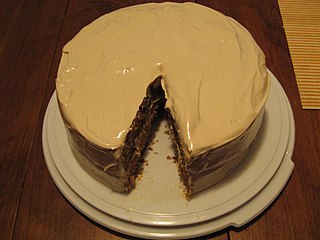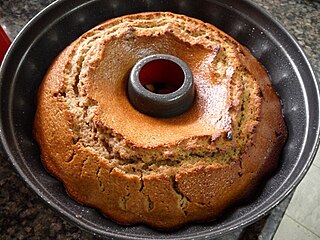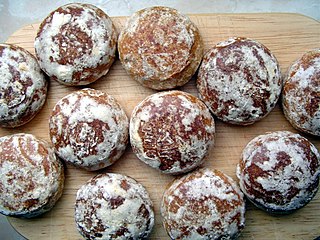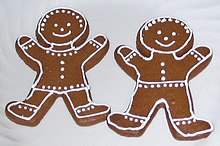
A cookie or biscuit is a baked snack or dessert that is typically small, flat, and sweet. It usually contains flour, sugar, egg, and some type of oil, fat, or butter. It may include other ingredients such as raisins, oats, chocolate chips, or nuts.

Dessert is a course that concludes a meal. The course consists of sweet foods, such as cake, biscuit, ice cream and possibly a beverage such as dessert wine and liqueur. Some cultures sweeten foods that are more commonly savory to create desserts. In some parts of the world there is no tradition of a dessert course to conclude a meal.

Confectionery is the art of making confections, which are food items that are rich in sugar and carbohydrates. Exact definitions are difficult. In general, however, confectionery is divided into two broad and somewhat overlapping categories: bakers' confections and sugar confections. The occupation of confectioner encompasses the categories of cooking performed by both the French patissier and the confiseur.

A biscuit, in most English speaking countries, is a flour-based baked and shaped food item. Biscuits are typically hard, flat, and unleavened. They are usually sweet and may be made with sugar, chocolate, icing, jam, ginger, or cinnamon. They can also be savoury, similar to crackers. Types of biscuit include sandwich biscuits, digestive biscuits, ginger biscuits, shortbread biscuits, chocolate chip cookies, chocolate-coated marshmallow treats, Anzac biscuits, biscotti, and speculaas.

Lebkuchen, Honigkuchen or Pfefferkuchen are honey-sweetened German cakes, moulded cookies or bar cookies that have become part of Germany's Christmas traditions. They are similar to gingerbread.

Shortbread or shortie is a traditional Scottish biscuit usually made from one part white sugar, two parts butter, and three to four parts plain wheat flour. Shortbread does not contain any leavening, such as baking powder or baking soda. Shortbread is widely associated with Christmas and Hogmanay festivities in Scotland, and some Scottish brands are exported around the world.

A gingerbread house is a novelty confectionery shaped like a building that is made of cookie dough, cut and baked into appropriate components like walls and roofing. The usual base material is crisp gingerbread, hence the name. Another type of model-making with gingerbread uses a boiled dough that can be moulded like clay to form edible statuettes or other decorations. These houses, covered with a variety of candies and icing, are popular Christmas decorations.

Pennsylvania Dutch cuisine is the typical and traditional fare of the Pennsylvania Dutch.

Spice cake is a type of cake that is traditionally flavored with a mixture of spices. The cake can be prepared in many varieties. Predominant flavorings include spices such as cinnamon, cloves, allspice, ginger, and nutmeg.

Christmas cookies or Christmas biscuits are traditionally sugar cookies or biscuits cut into various shapes related to Christmas.

Stack cake, also called apple stack cake, is a stack of cakes layered with filling. Traditionally the cakes are made in a cast iron skillet, but they can be baked as well. The cake batter itself is made with molasses, and makes a crisp cake, similar to shortbread or biscuit. The apple filling for the cake can be made with applesauce, apple butter, apple jelly, re-hydrated preserved apple rings, or other types of filling can be used such as apricot, date and raspberry. The cake is a specialty of Appalachian cuisine.

A gingersnap, ginger snap, ginger nut, or ginger biscuit is a biscuit flavored with ginger. Ginger snaps are flavored with powdered ginger and a variety of other spices, most commonly cinnamon, molasses and clove. There are many recipes. The brittle ginger nut style is a commercial version of the traditional fairings once made for market fairs now represented only by the Cornish fairing.

Parkin is a gingerbread cake traditionally made with oatmeal and black treacle, which originated in Northern England. Often associated with Yorkshire, it is widespread and popular elsewhere, notably in Lancashire. Parkin is baked to a hard cake but with resting becomes moist and even sometimes sticky. There are regional differences, for example in Hull and East Yorkshire, it has a drier, more biscuit-like texture than in other areas whereas in Lancashire it is generally made with golden syrup rather than the treacle used elsewhere. Parkin is traditionally eaten on Guy Fawkes Night, 5 November, and when celebrating 'Yorkshire Day' on 1 August. But is also enjoyed throughout the winter months. It is baked commercially throughout Yorkshire, but is mainly a domestic product in other areas.

Bredele are biscuits or small cakes traditionally baked in Alsace and Moselle, France, especially during the Christmas period. Many varieties can be found, including new ones, so that assortments can be created. They can include anisbredelabutterbredle, schwowebredle, spritzbredle, small pain d'épices and spice cakes that are made with sugar rather than honey.

Pfeffernüsse are small spice cookies, popular as a holiday treat with Germans and ethnic Mennonites in North America. Similar cookies are made in Denmark, and The Netherlands, as well. They are called Pfeffernüsse in German, pepernoten in Dutch, päpanät in Plautdietsch, pfeffernusse or peppernuts in English, and pebernødder in Danish.

Scottish cuisine encompasses the cooking styles, traditions and recipes associated with Scotland. It has distinctive attributes and recipes of its own, but also shares much with other British and wider European cuisine as a result of local, regional, and continental influences—both ancient and modern.

A Cornish fairing is a type of traditional ginger biscuit commonly found in Cornwall, England, United Kingdom. "Fairing" was originally a term for an edible treat sold at fairs around the country, though over time the name has become associated with ginger biscuits or gingerbread, which were given as a treat to children or by men to their sweethearts. In Cornwall, fairings contained ginger and became famous around the country when a Cornish manufacturer started selling them by mail order in 1886. The same manufacturer still makes them and the company has recently teamed up with celebrity chef Rick Stein to make biscuits.

Lekach is a honey-sweetened cake made by Jews, especially for the Jewish holiday of Rosh Hashanah. Known in Hebrew as ugat dvash, the word lekach is Yiddish. Lekach is one of the symbolically significant foods traditionally eaten by Ashkenazi Jews at Rosh Hashanah in hopes of ensuring a sweet New Year.

Pryanik refers to a range of traditional sweet-baked goods in Russia, Ukraine, Belarus and some neighboring countries such as in Poland. It is also a popular Czech and Slovak sweet.



























